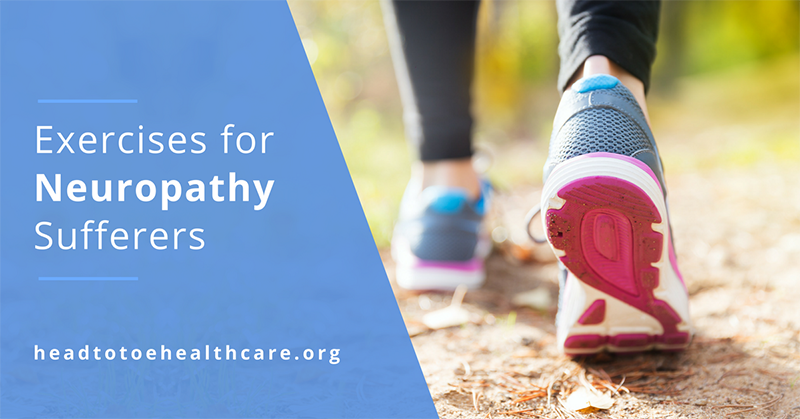Exercising with Neuropathy
When it comes to exercise, sufferers of severe peripheral neuropathy in their feet are often faced with an unfortunate catch-22.
On the one hand, it’s well known that regular exercise is one of the most important home management strategies for neuropathy prevention and management.
Exercise helps you improve your blood flow, fight inflammation, and reduce pain. It can help you manage your blood sugar, improve your balance, and strengthen your legs and ankles so you’re more stable. The benefits are numerous.
But on the other? The symptoms of neuropathy make it increasingly difficult to get meaningful exercise safely. It maybe inadvisable (or even impossible) to do the active things you use to love, like hiking or playing basketball. The risks may be simply too great.
You can’t trust your sense of balance or coordination to keep you from tumbling, and you can’t trust your own pain receptors to identify serious injuries until it’s too late.
So, What’s the Solution?
You know you need exercise to stay healthy and fight your neuropathy. Without it, your symptoms will only get worse and worse, and your risk of a devastating complication (foot wounds, amputations) will continue to increase.
Yet you feel you can’t exercise safely, due to balance or sensations issues. What do you do?
Here’s our two-pronged solution:
- Identify which exercises and exercise plans are going to give you the greatest benefit with the lowest risk, depending on your symptoms. (If you have neuropathy, always consult a doctor before beginning any new exercise program.)
- Seek professional treatment for your neuropathy from Head to Toe Healthcare—our advanced procedures may be able to restore some nerve function and help you increase the range of activities that are safe to perform.
Exercises for Neuropathy Sufferers
Before we get further into this section, we’re going to remind you—always consult with a doctor (either us or your general practitioner) before beginning a new exercise plan.
While we can give you a general sense of what you can probably expect, a doctor will be able to give you more specific details and information about which exercises are safe for you—and which ones aren’t. Such matters must be evaluated in person on a case by case basis.
With that caveat out of the way, let’s look a bit more closely at what your exercise plan might look like.
Aerobic Exercise / Cardio
We’re going to dive right into the heart of the matter here. This is where the vicious, downward cycle so often occurs. But while unchecked peripheral neuropathy can slow you down, it doesn’t have to keep you from getting the aerobic exercise you need.
You just have to be smart about it. The best aerobic exercises for severe peripheral neuropathy sufferers are those that get your heart pumping without generative significant impact forces on your feet or joints.
As it turns out, brisk walking is both one of the easiest and best ways to do this for most people with neuropathy. Running is too high impact (and risky if you have balance issues), but walking over flat terrain is much safer for most. Other potential aerobic options include swimming, water aerobics, cycling, or even tai chi.
Thirty minutes of moderate intensity aerobic exercise at least three times per week, combined with a more active and less sedentary lifestyle generally, can go a long way toward relieving neuropathic pain and preventing further deterioration to nerves.
Stretching
Keeping your feet, legs, and ankles flexible and limber helps with your neuropathy in a few of ways. First, just like aerobic exercise, it improves the efficiency of blood flow through your lower limbs. Second, it helps improve balance—more on that in a bit. And third, it reduces the risk of developing an injury during other types of exercise.
Calves and hamstrings are especially important to stretch regularly. This might include, for example:
- Standing calf stretch. Step backward with one leg, keeping the knee straight and the heel flat on the floor. Lean forward with your bent front leg until you feel the stretch in your rear calf.
- Sitting hamstring stretch. Sit on the front of a sturdy chair and extend one leg—knee straight, toes pointing up, heel on the floor. (The other leg should be bent and flat on the floor.) Lean forward at the hips, keeping your back straight and your chest over the straight leg until you feel a stretch in your hamstring.
Strength Training
Building strength in the lower legs and feet is also hugely important for people with peripheral neuropathy. Crucially, it helps to counteract some loss of muscle strength and control associated with various forms of peripheral neuropathy. It also provides for better balance, stability, and injury resistance.
Your doctor might suggest heel drops and calf raises, which you can do on an ordinary staircase with a sturdy railing for support. Stand on the edge of a stair, with the balls of your feet on the step but the heels overhanging the edge. Slowly drop your heels below the level of the stair, then slowly level them again. Next, slowly rise up on your tiptoes, then lower back down to level.
Balance Training
Both stretching and strength training help improve and develop balance and stability, but it’s very worth it to do some additional dedicated balance training as well.
Once again, the good news is that you don’t need any special equipment or training to do these at home. Even an extremely simple exercise, such as standing on one foot for as long as you are able (up to about 30 seconds), can be extremely beneficial. Stand next to a table, wall, counter—something sturdy that you can cling to for support if necessary.
As your balance improves, you can increase the difficulty (and the benefit) of the exercise in a number of ways. For example, you might:
- Remove your hands from the support
- Close your eyes while balancing
- Stand on a pillow or other semi-unstable surface
Treatment for Neuropathy
Other doctors may have told you that there’s no real hope for neuropathy—that, at best, all you can do is reduce the pain and slow the rate of damage. That isn’t true!
While there’s no guarantee that existing nerve damage can be fully reversed, recent technological advances in neuropathy treatment are making extraordinary changes in the lives of our patients.
Even if nerve health and function are only partially restored, it could be more the enough to help you walk without pain again, or be able to do the things you use to love—hiking, driving, playing with the little ones, and more.
And over the long term, it could be the difference maintaining your mobility and independence into old age or losing a foot to ulceration and amputation.
Head to Toe Healthcare’s Tucson Neuropathy Institute is positioned on the cutting edge of neuropathy treatment, with options like guided cortisone injections, radiofrequency nerve ablation, laser therapy, and Dellon nerve decompression surgery.
If damaged nerves in your feet are making your world smaller and preventing you from enjoying the things you love, please give us a call today and find out if we can help you.
To schedule an appointment with us, call (520) 545-0202 today.
Contact Us
Office Hours:
Monday - Friday
8:00AM - 5:00PM
Tucson Foot & Ankle Institute:
7406 N. La Cholla Blvd.
Tucson, AZ 85741
Phone: (520) 545-0202
Fax: (520) 545-0201
© Tucson Foot and Ankle Institute. All Rights Reserved. | Privacy Policy



